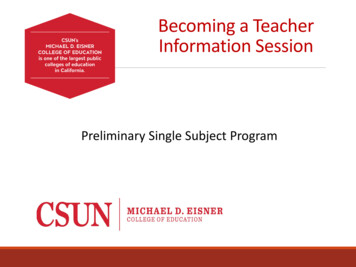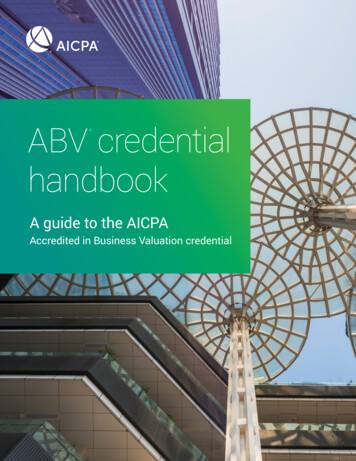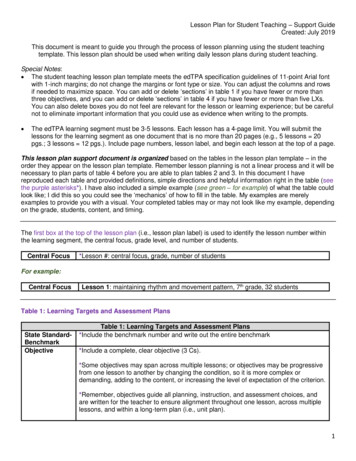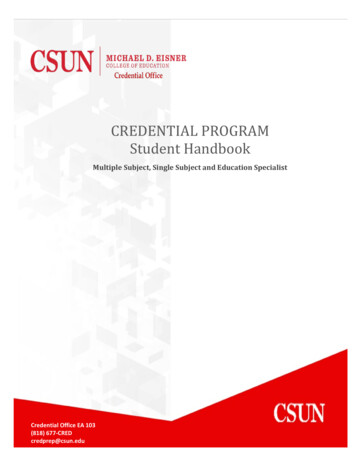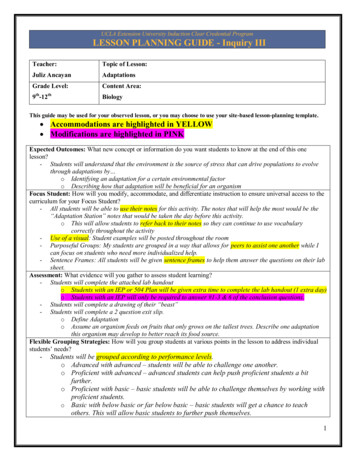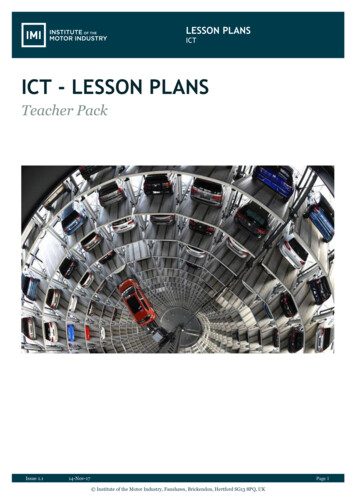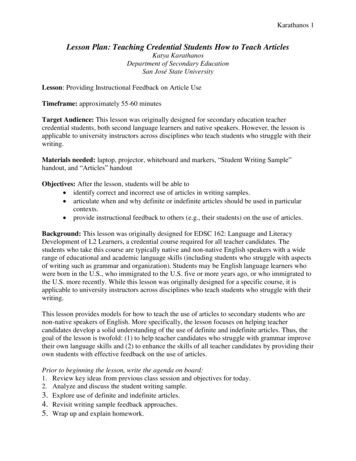
Transcription
Karathanos 1Lesson Plan: Teaching Credential Students How to Teach ArticlesKatya KarathanosDepartment of Secondary EducationSan José State UniversityLesson: Providing Instructional Feedback on Article UseTimeframe: approximately 55-60 minutesTarget Audience: This lesson was originally designed for secondary education teachercredential students, both second language learners and native speakers. However, the lesson isapplicable to university instructors across disciplines who teach students who struggle with theirwriting.Materials needed: laptop, projector, whiteboard and markers, “Student Writing Sample”handout, and “Articles” handoutObjectives: After the lesson, students will be able toidentify correct and incorrect use of articles in writing samples.articulate when and why definite or indefinite articles should be used in particularcontexts.provide instructional feedback to others (e.g., their students) on the use of articles.Background: This lesson was originally designed for EDSC 162: Language and LiteracyDevelopment of L2 Learners, a credential course required for all teacher candidates. Thestudents who take this course are typically native and non-native English speakers with a widerange of educational and academic language skills (including students who struggle with aspectsof writing such as grammar and organization). Students may be English language learners whowere born in the U.S., who immigrated to the U.S. five or more years ago, or who immigrated tothe U.S. more recently. While this lesson was originally designed for a specific course, it isapplicable to university instructors across disciplines who teach students who struggle with theirwriting.This lesson provides models for how to teach the use of articles to secondary students who arenon-native speakers of English. More specifically, the lesson focuses on helping teachercandidates develop a solid understanding of the use of definite and indefinite articles. Thus, thegoal of the lesson is twofold: (1) to help teacher candidates who struggle with grammar improvetheir own language skills and (2) to enhance the skills of all teacher candidates by providing theirown students with effective feedback on the use of articles.Prior to beginning the lesson, write the agenda on board:1. Review key ideas from previous class session and objectives for today.2. Analyze and discuss the student writing sample.3. Explore use of definite and indefinite articles.4. Revisit writing sample feedback approaches.5. Wrap up and explain homework.
Karathanos 2Introduction to Lesson [2 minutes]:In our previous class meeting, we discussed various approaches to providing instructionalfeedback to secondary students (particularly English learners) who struggle with aspects of theiracademic writing. In particular, we emphasized the importance of commenting on strengths of astudent’s writing as well as providing instructional feedback on patterns of errors evident in astudent’s writing. Today we are going to analyze a student writing excerpt, focusing on one ofthe patterns of errors evident—misuse of articles. We will explore the “grammar” of when andwhy we use definite and indefinite articles. By the end of this lesson, you will be able to provideinstructional feedback to students related to this aspect of grammar.Procedure [45-50 minutes]:Step 1: Analyze writing sample [8-10 min]We are going to begin by reading through the writing sample you have been given, which is anexcerpt from an assignment written by a former student in the program. The reading that thestudent is responding to in this excerpt is an article by Robin Scarcella highlighting a majorproblem in our public schools: English learner students are not getting adequate instruction inacademic language development and writing. As we read through the excerpt aloud, please takenote of any instances where you believe the writer has made an error in the use (or omission) ofarticles. Ask volunteers to read parts of the excerpt aloud. Now, I would like you to take a coupleof minute to think silently about what feedback you would give the student related to the errorshe has made. (e.g., “The student should write the author instead of simply author since he’sreferring to a specific noun.”)Step 2: Class discussion [13-15 min]Now we will have volunteers share their responses with the class. Please share one of the errorsyou identified (reading the sentence containing the error aloud) and briefly explain how youwould provide feedback to the writer. I will record highlights of each volunteer’s thoughts/ideason the whiteboard without further comment from me or other students (as later in the lesson wewill revisit the errors identified and the related feedback in more depth). As volunteers share,write key word/phrases from their explanations on the board. Continue having different studentsvolunteer until all six errors have been identified.It was very interesting to hear from you about how you would approach providing feedback tothis student on his writing errors related to articles. I noticed some specific language you used.[Recap some of the terms/language used by students such as “specific” “general,” etc. as wellas other aspects of their responses (e.g., how they seemed to know that an article should beused/omitted but weren’t quite sure how articulate the reason).]Step 3: Present PowerPoint [10-12 min]As educators, it is important for us to be able to articulate the rationale behind the correct orincorrect use of articles to our students. In order to provide this rationale, we need to be familiarwith the grammatical rules related to the use of definite and indefinite articles. Now, we aregoing to go over important rules that will help us accomplish this goal. Before beginning thePowerPoint presentation, provide students the “Articles” handout and explain that itcorresponds to the PowerPoint presentation. (Note that the information in the PowerPoint and
Karathanos 3handout covers general rules/guidelines related to the use of articles but does not cover themany exceptions to the rules that exist.) Engage students in the presentation by asking forvolunteers to read parts of the content. Ask questions to check for understanding and elaborateon information in the PowerPoint as needed.Step 4: Revisit writing sample [12-15 min]Now that you have a better understanding of when to use definite and indefinite articles, youshould also feel more confident in explaining these concepts to others. We are going to take afew minutes to revisit the writing sample we worked with earlier and review how you wouldprovide feedback to the writer about errors he has made with the use of articles. Choose a coupleof instances when the student used an article incorrectly and share with a partner how you wouldprovide instructional feedback to the student. Provide students with the example listed below.Example:The student writes, “The teachers tend to think . . .” when he is referring to all individuals of agroup of nouns; as such, the article should be omitted. I’d explain this rule to the student, and I’dtell him to omit the and instead write, “Teachers tend to think . . .”We will take about seven minutes to do this and then have volunteers share their thoughts withthe whole class.Closure/Evaluation [5 min]:Ask volunteers to share something they learned today that they feel will be helpful in providingstudents with instructional feedback on the use of articles.Tell the students to complete the exercises on the “Articles” handout for homework.In our next class meeting, we will review what we learned about articles today by having youshare your responses to the items in the exercises. Make sure that you’re able to explain yourrationale behind your use of articles.Lesson Analysis:The students (teacher candidates) in my course, Language and Literacy Development for L2Learners, must be able to support the academic language development of their own middle andhigh school students, many of whom will be English learners (EL’s). As such, it is critical thatteacher candidates not only model appropriate academic language for their students but also havethe tools to assist students in developing their English language skills. The inquiry-basedapproach used in this lesson focuses on providing instructional feedback to students on the use ofarticles. This is an effective approach with students who take this class (who typically have awide range of academic language skills). In the process of focusing on how to provide feedbackto students on the use of articles, teacher candidates who struggle with their own academiclanguage will have an opportunity to enhance their language skills. Moreover, all teachercandidates will develop confidence and skills in providing specific instructional feedback tostudents on this aspect of grammar.
Source: Homegrown Handout on Articles developed by Nick Chu(SJSU Writing Center)Katya Karathanos, Ph.DSecondary EducationSpring 20121
Articlesy The articles a, an, and the are adjectivesused to modify nouns.y A and an are indefinite articles used tomodify nouns from a larger group ofnouns (e.g., an egg from a carton ofeggs).y The is a definite article used to modify aspecific noun (e.g., the egg I ate forbreakfast).2
When to use a or any When the noun modified is indefinite or non‐specific,referring to any member of a group of nouns1. We packed your clothes in a box in the garage.2. We need a box for Johnny’s toys.y To decide between a and an, think about the sound of thebeginning of the next word. Use a when the next wordbegins with a consonant sound, as in a book or a usefulbook. Use an when the next word begins with a vowelsound, as in an apology.3
When to use they When the noun modified is definite or specific1. We packed your t‐shirts in the box with redtape in the garage.2. We need the largest box for Johnny’s toys.In these examples, we are not referring to justany box, but rather, to specific boxes.4
Examples of ways nouns can be specific1. When a phrase describes the noun: Through mystudies, I will gain the skills needed to be a pharmacist.The phrase needed to be a pharmacist tells us whichkind of skills.2. When the noun is mentioned earlier in the text: Weinterviewed an economics student for his opinion onthe situation. The student was opposed to budget cuts.3. When the reader is familiar with the noun: Before youcome outside, grab the car key.5
Examples of ways nouns can be specific4. When the noun is one of a kind: I want to visit the Louvre inParis and the Great Wall in China, and I also want to meet theQueen when I go to England!Only one of each of these items exists in the world, so we know exactlywhich nouns are being referred to.5. When using the superlative: Elephants are the largest animalson land.The superlative is an adjective like fastest, smartest, or least healthy thatindicates that the noun is faster, smarter, or less impressive than anythingelse that it is compared to.6
When not to use articles1. Never use an article with any part of speech besides a noun(such as with an adjective or a verb).Incorrect: Sammy is the black.Correct: Sammy is the black dog.2. Never use a or an with a plural noun.Incorrect: They sat down at a tables.Correct: They sat down at a table/the table/the tables.(depending on context)7
When not to use articles3. Never use a or an with a noun that cannot be counted.Examples of nouns that cannot be counted areresearch and information.Incorrect: We received an information about thepatient’s treatment.Correct: We received information about the patient’streatment. We received the information (that thedoctor sent us) about the patient’s treatment.8
When not to use articles4. When making a statement that refers to all individuals of agroup of nouns, do not use an article.Incorrect: I am afraid of the snakes.Correct: I am afraid of snakes.5. When making a statement about something in general, donot use an article. In many non‐English languages, nounssuch as love and childhood take an article in generalstatements; however, this is not the case in StandardEnglish.Incorrect: The childhood is difficult without friends.Correct: Childhood is difficult without friends.9
Source:y Homegrown Handout on Articles developed by NickChu (SJSU Writing Center) available es/handouts/Articles.pdf10
Student Writing SampleVan graduated from high school without knowing how to write academically inEnglish. However, there are many students who are insufficient in writing just like her. In thearticle “Balancing Approaches to English Language Instruction” by Robin Scarcella, author talksabout how the schools and teachers are not helping those students who need help with theirwritings. She claims that there has to be a balance in instructions.Van talks about how she was never assigned to any demanding assignments in school. Englishlearners tend to get assigned to easier assignments. However, their standards and expectationsshould be placed higher and not lower. Van asserts that she was willing to work if her teachersgave her more challenging homework. The teachers tend to think that assigning complicatedassignments will discourage students but there has to be a fine balance. The homework andassignments should not be too easy for students. I completely understand how Van feels. I feltthe same way when I was in high school. I passed my classes not really knowing how to writeacademically and when I got to college, I realized how uneducated I was. No one had reallyassessed me about my writing and when I took WST for the first time, I realized that I had somework to do. One time, I showed my English paper to my colleagues and they thought it was ajoke. They could not believe I was turning in an assignment with such a horrible writing. I amstill struggling to be able to write academically.As a second language learner myself, I will balance my assignments for my students so that itwill push them. If they are making mistakes in their writing, it has to be addressed. I amthankful to my English 100W teacher at SJSU for pushing me to do better. If she didn’t addressmy problems, I would not be at the level that I am today.
San José State Writing Centerhttp://www.sjsu.edu/writingcenter/Written by Nick ChuArticlesThe articles are a, an, and the. Articles modify nouns, as in the monkey or an astronaut. A and anare indefinite articles, meaning they address any noun from a larger group of nouns. The noundoes not have to be a specific noun: an egg from a dozen eggs. The is a definite article, meaningthat it points to a noun that is one of a kind: the egg I ate for breakfast.When to use a or anTo understand how to use indefinite articles, imagine someone telling you to choose an applefrom a basket. An apple can be any apple from the basket; it does not matter which particularapple we choose. We do not need to take the smallest apple or the only green apple from thebasket; we just need an apple. In the following examples, a points only to nonspecific nouns; it isunclear exactly which box the speaker is referring to.a. We packed your clothes in a box in the garage.The box could be any box in the garage.b. We need a box for Johnny’s toys.A box is needed, but we do not know if it is the box in my room or the box in theback of the car.To decide between a and an, think about the sound of the beginning of the next word. Use awhen the next word begins with a consonant sound, as in a book or a useful book. Use an whenthe next word begins with a vowel sound, as in an apology.When to use theUsing the same apple example, think of using the like having to choose one specific apple fromthe basket. This is not just any apple but the most delicious apple, the apple that weighs the most,or the apple that Jim’s mother wanted. The examples below demonstrate the ways that nouns canbe specific.1) When a phrase describes the noun: Through my studies, I will gain the skills neededto be a pharmacist. The phrase needed to be a pharmacist tells us which kind of skills.2) When the noun is mentioned earlier in the text: We interviewed an economicsstudent for his opinion on the situation. The student was opposed to budget cuts.From the first sentence, we know that the student in the second sentence is the economicsstudent who was interviewed.3) When the reader is familiar with the noun: Before you come outside, grab the carkey. The reader is expected to know that this is not just any key but specifically the key tostart the car.4) When the noun is one of a kind: I want to visit the Louvre in Paris and the GreatWall in China, and I also want to meet the Queen when I go to England! Only one ofthese items exists in the world, so we know exactly which nouns are being referred to.5) When using the superlative: Elephants are the largest animals on land. Thesuperlative is an adjective like fastest, smartest, or least healthy that indicates that thenoun is faster, smarter, or less impressive than anything else that it is compared to. Whenusing the superlative, the must always be used before the adjective, as in the fastestrunner or the least healthy child.
San José State Writing Centerhttp://www.sjsu.edu/writingcenter/Written by Nick ChuWhen not to use articles1) Never use an article with any part of speech besides a noun. For instance, do not usean article to modify an adjective or a verb. In the following incorrect sentence, theincorrectly modifies black. The should modify a noun, such as dog.Incorrect: Sammy is the black.Correct: Sammy is the black dog.2) Never use a or an with a plural noun.Incorrect: They sat down at a tables.Correct: They sat down at a table/the table/the tables. (depending on context)3) Never use a or an with a noun that cannot be counted. Examples of nouns that cannotbe counted are research and information. We can leave out the article to refer to thesenouns in a general sense, or we can use the to refer to a specific noun.Incorrect: We received an information about the patient’s treatment.Correct: We received information about the patient’s treatment. We received theinformation (that the doctor sent us) about the patient’s treatment.4) When making a statement that refers to all individuals of a group of nouns, do notuse an article. In the following example sentence, the speaker is afraid of all snakes.Incorrect: I am afraid of the snakes.Correct: I am afraid of snakes.5) When making a statement about something in general, do not use an article. In manynon-English languages, nouns such as love and childhood take an article in generalstatements. A roughly translated sentence might look like this: The childhood is difficultwithout friends. In a standard English sentence, however, childhood would not take anarticle because it is not a specific childhood (e.g. the childhood of a shy boy).Incorrect: The childhood is difficult without friends.Correct: Childhood is difficult without friends.ExercisesPart A. Insert the appropriate articles or omit them (use a zero article) where needed.1. I want to bring sandwich to picnic at the park.2. The professor requires three textbooks. Fortunately, textbooks for this class areinexpensive.3. I need to look at manual for the coffer maker.4. Immigrants who came to United States saw Statue of Liberty.5a. Carlos is afraid of mice. (generalization)5b. Carlos is afraid of mice. (specific: mice in his bedroom)6. She has laziest coworkers in the world.7. Children/children always know things that adults do not. (generalization)8. Do you have opinion on this paint color?Part B. Identify and correct the errors in article usage in each sentence.1. According to a research, there are no bodies hidden inside Great Wall of China.2. She is currently undergoing a rehabilitation.3. The love is most important thing in world.
San José State Writing Centerhttp://www.sjsu.edu/writingcenter/Written by Nick ChuKeyPart A.1) a; the2) the3) the4) the; the5a)5b) the6) the7) ;8) anPart B.1) According to the/ research, there are no bodies hidden inside the Great Wall of China.Research is noncount, so it cannot take an indefinite article (a or an). We can use the ifwe know which specific piece of research provided the information (such as the researchconducted by satellite technology), or we can use a zero article to refer to research ingeneral. The Great Wall of China is a proper noun and normally takes a definite article.2) She is currently undergoing rehabilitation.Since rehabilitation is a noncount noun, it is not preceded by an indefinite article. Ittypically does not take a definite article, either, unless the speaker has specified aparticular source of rehabilitation (the rehabilitation that the doctor proposed). The bestchoice in this situation is to use the zero article.3) Love is the most important thing in the world.Love in this sentence is part of a generalization and is a noncount noun, so it can takeneither a definite article nor an indefinite article. World is a count noun, yet only onespecific world exists (the world that we live in), so it takes a definite article.Works consulted:Lunsford, Andrea A. The Everyday Writer. 4th ed. Boston: Bedford/St. Martin’s, 2010. Print.Lynch, Paul, Allen Brizee, and Elizabeth Angeli. “Using Articles.” Purdue Online Writing Lab.The Writing Lab and Purdue at OWL at Purdue and Purdue U, 2011. Web. 11 Nov. 2011.
the U.S. more recently. While this lesson was originally designed for a specific course, it is applicable to university instructors across disciplines who teach students who struggle with their writing. This lesson provides models for how to teach the use of articles to secondary students who are non-native speakers of English.

